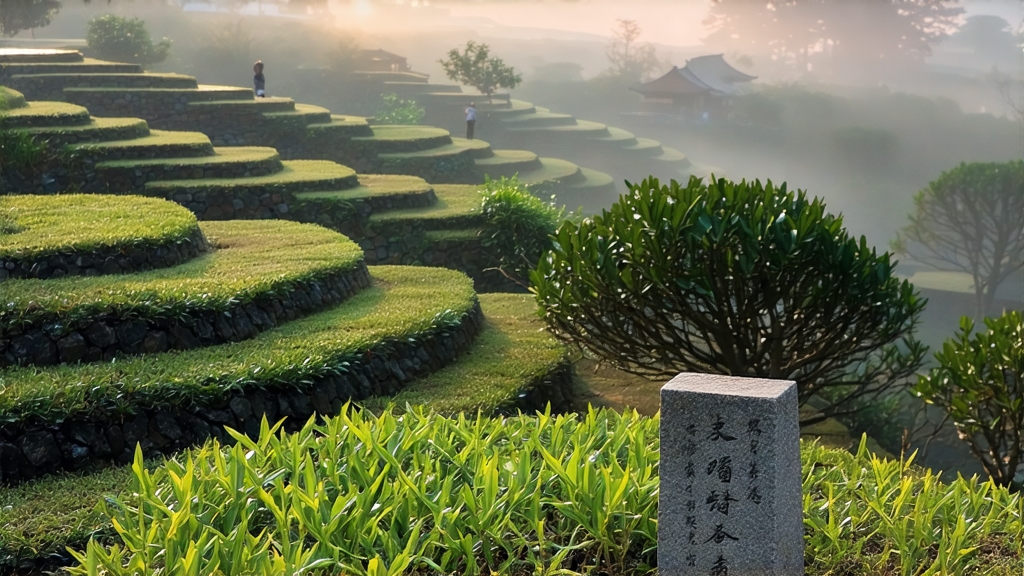
Tucked high on the northern rim of the Sichuan Basin, where the Min River carves misty corridors between 30-kilometre-long ridges, lies Meng Ding Mountain—legendary birthplace of the world’s first cultivated tea garden and home to the most discreetly glamorous of all yellow teas, Meng Ding Huang Ya. While green tea’s jade freshness and pu-erh’s post-fermented depth often monopolise the foreign gaze, yellow tea occupies a slender, almost secret aisle in China’s tea taxonomy. It is neither fully oxidised nor aggressively baked; instead it spends a night or two wrapped in damp cloth, breathing its own floral vapours until the leaf edges turn the colour of antique parchment. Meng Ding Huang Ya is the variety that best captures this alchemical pause—an emissary from the Tang dynasty that once travelled the Tea-Horse Road to Lhasa and, in 724 CE, entered the imperial ledger as a “first-rank spring tribute”.
History: From Daoist Altar to Imperial Cup
Myth credits the Daoist monk Wu Lizhen with planting seven tea bushes on Meng Ding’s summit around 53 BCE, an act still commemorated during the annual “Spring Tea Offering” when white-robed villagers sprinkle rice wine on those venerable shrubs. By the Song dynasty the mountain’s output had become so coveted that county magistrates posted armed guards at the only pass. The Ming Veritable Records list Meng Ding Huang Ya among eight teas granted the right to use yellow silk wrapping—an honour otherwise reserved for the emperor’s own robes—hence the colour that eventually named the category. When the Qing court switched to darker, compressed teas for easier caravan transport, yellow tea retreated into local memory, surviving only because Buddhist monks on Meng Ding continued to produce tiny lots for medicinal use. Rediscovered during the 1958 national tea survey, the cultivar was revived with government funding; today 240 farming households share a 600-hectare protected zone between 800 m and 1,400 m elevation, where the annual frost-free period lasts exactly 269 days—long enough to coax amino acids into the bud but short enough to keep the leaf temperately tender.
Micro-terroir: Cloud Forest in a Cup
The mountain’s classic verse boasts “rain by morning, sun by noon, cloud by dusk,” a diurnal rhythm that creates a 70 % average humidity and a UV index softened by 32 foggy days each spring. Granitic soils, rich in potassium and porphyritic quartz, drain rapidly so that roots are alternately drenched and oxygenated, concentrating the sweet compound L-theanine. Farmers identify three micro-zones: the summit “Royal Altar” (Gong Cha Di) whose tea yields a lilac note; the mid-slope “Immortal Bridge” redolent of steamed maize; and the lower “Five-Dragon Well” that carries a faint ginger spiciness. International labs have measured Meng Ding Huang Ya’s EGCG at 9.8 %—lower than West Lake Longjing—yet its soluble sugars reach 5.3 %, explaining the silky, almost custard-like texture that lingers on the lateral tongue.
Cultivar & Plucking Code
The traditional clone is a local variant of Camellia sinensis var. sinensis nicknamed “Old-Fish-Leaf” because the lowest subtending leaf is shaped like a carp tail. Only the spring “before-rain” fortnight is deemed worthy: two standards exist, “Xiao Ya” (pure unopened bud, 12–15 mm) and “Da Ya” (bud plus first leaf, 20–25 mm). Experienced pickers finish before 9 a.m. so that the leaf temperature remains below 18 °C, preventing enzymatic browning during the downhill basket ride. A full kilogram of fresh pluck contains roughly 9,600 buds—enough, after the yellowing process, to yield just 200 g of finished tea.
Craft: The Art of Men Huang—Sealing the Breath
Yellow tea’s signature is the “men huang” (闷黄) step, a controlled suffocation that sits between green tea’s kill-green and white tea’s withering. On Meng Ding the sequence unfolds over four days:
- Sha Qing (Kill-green): 180 °C drum panning for 3.5 min reduces moisture to 55 % and deactivates 95 % of polyphenol oxidase.
- Re Nian (Hot rolling): A 50 °C bamboo sleeve